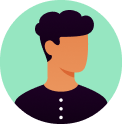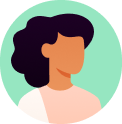Dreams
12 - 30 april 2021
Dreams is a consumer app that uses behavioral science to design financial services, making it easier to save, invest and pay off debt.
The fintech company was founded in 2013 in Sweden and has now, 2021, been downloaded over 400,000 times and have helped to create over a million dreams.
The mobile app is provided on iOS, Android and the Web. In 2021 it is offered in Sweden and Norway and will later this year expand to Germany. In 2022 Dreams goal is set on United Kingdom. They also have plans to expand to Asia, Africa and the Middle East.
Dreams have been awarded at several occasions and in 2018, the startup was named a Rising Star as part of the KPMG Fintech 100 Awards.
The team and I
In this project, Nadr Jamal, took on the role as the project leader and the rest took on the role as team members. All of us were, however, very active in the whole process and my main role was to facilitate, document, interview, design and test the prototype and visuals.
Amir Emami
Antonella Jonsson
Denise Swartling
Libin Abdulkadir
Nadr Jamal
Rana Alchachino
Rebecka Dahlgren
The brief
The three weeks design challenge would consist of solving the following question and presenting a prototype to visualize the solution.
How can Dreams understand what our customer’s needs are and tailor the upsell and cross sell experiences based on this in our app?
Apart from the prototype we also delivered a written report and a pitch presentation for the stakeholders.
Understanding the challenge
We started by interviewing the stakeholders at Dreams so we could get as much information as needed to understand the challenge from their point of view.
There were many different aspects of the challenge we had been given. We needed to understand both existing customers needs, but also needs of non-existent users.
If we could understand those needs we would also be able to offer them more of Dreams products and be aware of future needs.
Understanding users
When we felt we had a good understanding of the challenge according to the stakeholders views we then wanted to understand the customers perspective.
We created two surveys in Google Forms to collect data and insights from both users of the app and non-users. The links to the surveys were posted on the team members' social media accounts and sent to other students, friends and families.
A total of 120 answers were collected. We wanted to combine both a quantitative research method with surveys and a qualitative in the form of interviews.
We conducted five interviews with non-users to get a deeper insight of their motivations and view on both saving and saving-apps specifically. Ultimately, we would have interviewed existing users, as well as previous users, but unfortunately we could not get hold of any of these users for our interviews. We did, however, get those important insights through our surveys.
The interviews were conducted both in person as well as through the phone. We created a template with questions to use as a guide but left space for follow up questions and to use a semi-structured approach if necessary.
Key take aways from survey and interviews
1.
Motivation is key for starting to save or pay off debts
2.
Saving or paying off debts together with someone else keeps you motivated
3.
A combination of encouragement and engagement keeps users loyal
How might we
In this project we succeeded in collecting a fairly large amount of data. We analyzed this data and boiled it down to eight areas that were of interest as the picture below shows.
Usually defined as "problem areas" we now wanted to reframe our insight statements as how-might-we-questions, to turn it in to opportunities for design improvement. I have learned over time that there are almost always some sort of solution available, as long as you think of it as a possibility of improvement instead of a problem. There were many areas that we were interested to improve. We needed to focus, however, and after voting we had three statements that we wanted to focus on.
How can Dreams create an excellent customer experience where users feel engaged and safe with sharing information?
How can we activate the non-active users?
How can we motivate users to keep using Dreams for the long-term?
Three hypothesis
Group Saving
Mascot
Budget Tracker
Group Saving
Our data showed that group saving is a motivator for people to start and continue saving through accountability.
Since Dreams wanted help to tailor the upsell and cross sell experiences in the app, we wondered if we could combine the motivation of group saving and giving customers a helping hand in choosing funds for long-term dreams instead of just saving. Would this be possible? Probably.
We believed that more people will get into fund saving if there is a feature that pops up, telling them about fund saving, acting like a motivator and as a source of support.
This is of course the same for any sort of saving.
Mascot
We wanted to personalize the experience for users of Dreams. We wanted people to feel welcomed and comfortable in the financial world, which is hard for many.
We also wanted to make fund saving and debt repayment sound way less frightening and serious. And why not through a friendly mascot easing the way through financial decisions and hardships? We believed that a mascot could help users make use of more of the app’s features and motivate them.
We did a lot of research about mascots and found out that they are not only a charming add-on but they can also be a savvy business tool.
Budget tracker
This idea came to us through mainly our interviews. Our interviewees wanted to see their economic status, they wanted to have an overview over their economy so they could track their expenses and earnings, which would hopefully lead to them being able to save more in Dreams.
Even though we as a group really liked this hypothesis, we only had a short period of time for this project, and we felt that this idea was not the best of our three hypothesis. We also got this confirmed by the stakeholders over a meeting. Therefore, we put this idea aside and focused on the other two hypothesis.
However, we kept the focus of simplifying users economic status through the whole process, and managed to add that function in our final prototype.
Time for some prototyping
We did a total of two user tests on two sets of prototypes that we created in Figma.
I will now go through the different steps that we took which then lead to our high-fidelity prototype that we delivered to the stakeholders at Dreams.
Who does not love a warm welcome?
Personalization and nudging
One of Dreams goals was to get closer to their customers, so they could get to know their needs better. One of our hypotheses was to ease the onboarding experience with a mascot, the mascot would also follow the user through the whole customer journey.
We also wanted to give the users a personalized experience and create motivators to engage the inactive users. By asking the user to answer a few questions about themselves at the start, it is possible to gather more information about the user´s preferences to make the whole customer journey more personalized. With information it is also much easier for Dreams to target users and offer them other solutions. Solutions that customers might not be aware exist.
The answers from our survey showed that users feel more comfortable to talk to someone they know about their economy, as well as a personal banker, who has a lot of knowledge. With this in mind we wanted to create a means of communication that was both familiar and could provide financial knowledge.
We used a money fairy as a mascot to both serve as a friendly face but also provide help. By having the fairy personally direct the user by name, this may create a sense of comfort and familiarity. The fairies interactions and frequency of interaction would be determined after the user's preference. The fairy serves as a help and guide to the user, by answering the questions in the beginning of the process it's possible to adjust how much help the fairy will provide.
Group savings
A more personalized experience
Users like to save in groups. We added a little bit of a nudge with the help of our mascot. In that way the mascot would make people aware of other services Dreams offer, like fund saving as an example. Through the whole customer journey, the mascot should congratulate, cheer on and motivate the user.
Debt management
The way to a brighter future
The data from our survey showed that many people, both non-existing Dreamers and existing Dreamers, were interested in debt management. Since we also knew that people get more motivated saving together, we gave them the option, from the start, to add other users to a debt plan. Another feature was an optional step-by-step plan to keep users motivated to become debt free.
Success stories
Be inspired and inspire others
In our interviews we learned that recommendation is the main reason why people download apps. As already mentioned, motivation seems to be important to get people to start saving money and getting people to take a step of becoming debt free. Being in debt can be an isolating and lonely experience where the user might feel very alone. With the help of our mascot, we wanted to add the option to share your success stories with other users. The idea is that this will serve as a motivator to the user but also motivate others to keep going.
Our user tests
Insights and findings
We did a total of two user tests on two sets of prototypes. After the first round of testing, we understood that we could improve some interactions. One example we improved was the graph explaining the overall saving – some users did not understand the content of the graph. There were also some buttons that needed to be fixed.
After receiving this feedback, we changed the buttons and the graph into a more easy-looking design. We tested our updated prototype with two new users and saw a big difference immediately. The testers did not get stuck in navigation and understood the user flow quite easily. There were some things that we improved after the second iteration but unfortunately, we did not have enough time to test on new users.
Results and feedback
What did the stakeholders at Dreams think of our work?
After three intensive weeks it was time to show stakeholders at Dreams what we had come up with. Apart from the prototype we also delivered a written report.
Some comments from our presentation;
“A really, really good presentation and awesome work!
Samare Jarf,
Senior Product Manager at
Dreams
“I really think you have found a lot of really good parts. I feel as a client that you have found things we should be doing.”
Samare Jarf,
Senior Product Manager at
Dreams
“I like your success stories and everything about the mascot.”
Samare Jarf,
Senior Product Manager at
Dreams
Dreams seemed to really like our work. They did say that if we had been given the same task again they had preferred if we went deeper into one hypothesis. If we had went even deeper into one hypothesis they would have even more to work with straight away. We as a group understood what they meant but we wanted Dreams to get the whole picture, because for us, it all works together.
If we had more time we would want to continue testing the mascot with users. None of our users had something negative to say about the fairy mascot. Is that because they have not been exposed to the fairy as often as they would if they used an app with a mascot? Is a fairy the best alternative of a mascot or are there any other that suits the purpose better?
We also encouraged Dreams to notify their customers in a personalized way, and not only for those who have not succeeded in their onboarding process, but also for those who did succeed and keep them warm during the whole customer journey. Success stories, however, we strongly encouraged Dreams to start with and it seems like they have incorporated success stories into their app.
I am very satisfied with our groups work, it was not easy three weeks but I am happy with the result we handed over to Dreams. Especially when I can see that you now can read of success stories in their app. I hope they continue to make it easy for users to share their own stories and be inspired by others. Hopefully some kind of mascot will be incorporated into the app in the future.



























